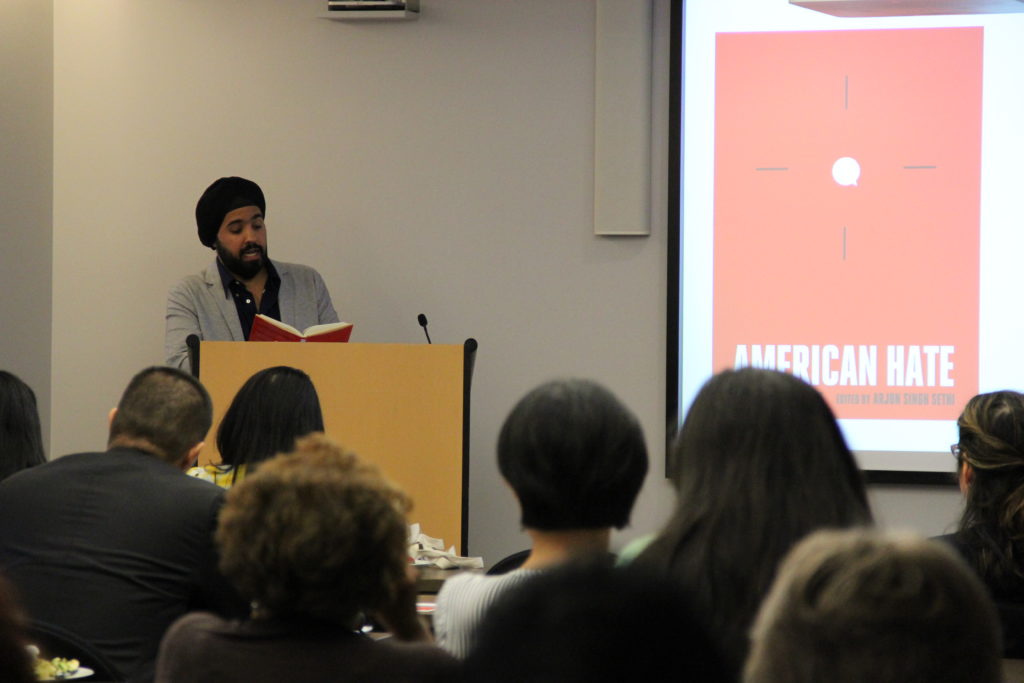
By: Amirah Fauzi, Program Associate, Pillars Fund
On August 12, 2016, after years of standing at the edge of his property and shouting at his neighbors, calling them “dirty Arabs,” “Mooslems,” and “dirty Lebanese,” Stanley Vernon Majors walks up to his neighbors’ front steps, then shoots, and kills Khalid Jabara.
On April 30, 2017, American University’s first black, female student government president is sworn in. The next morning, on her first full day in office, nooses and bananas are hanging around campus. Written across some of the bananas are the words “Harambe Bait,” referencing the gorilla killed in 2016 at the Cincinnati Zoo.
On May 25, 2018 on a Portland train a white man yells anti-Muslim hate speech towards two young black women, one of whom is wearing a headscarf. As three men try to subdue the harasser, he takes out a knife and kills two of the upstanders, wounding another.
These are just three of the many examples lawyer, activist, and author Arjun Sethi shares in his new book American Hate: Survivors Speak Out. Last month, the Pillars Fund, in collaboration with AAPIP Chicago (Asian Americans and Pacific Islanders in Philanthropy) held a dialogue with Sethi to discuss American Hate. The book is a collection of stories, those of 13 lives impacted by different forms of hate violence during and after the 2016 presidential election. They detail the horrifying actions inflicted and the psychological imprint left on survivors in the aftermath. The event was hosted by the MacArthur Foundation and co-sponsored by CAAIP (Chicago African Americans in Philanthropy) and CLIP (Chicago Latinos in Philanthropy).
When asked why he wanted to share these stories, Arjun Sethi responded, “It’s because we can argue about policy,” debating whether a policy is racist or not, “but we can’t argue about someone’s lived experience. It’s what happened. That’s the truth.”
If the correlation between President Trump’s rhetoric and the rising tide of hate violence is still not clear, it has now become common for perpetrators to use his name and rhetoric to threaten or taunt their victims.
“Interfaith conversations are not enough,” Sethi said. “We need to actually have conversations about white supremacy.”
Minimizing Barriers for Survivors
For many of us in the room, Sethi’s timely piece was not only an opportunity for us to learn, but to reflect as grantmakers and practitioners in philanthropy. When faced with such tragedies, it’s true that, as Sethi says, “our white allies need to step up,” but we all need to ask, how do we replicate white supremacy in our own work?
For those of us who identify with one or more of Trump’s targeted communities—Muslim, Latinx, immigrant, female, Black, Jewish, disabled, and the list goes on—these stories are and have been reflective of our own experiences, including my own. Less than a year ago, I sat with two of my friends when an imposing, white man cornered us in the dark while we talked at a local co-op’s outdoor patio. As we forcefully continued our conversation, ignoring the man blocking the end of our picnic table less than arm’s length away, he began blasting the national anthem on his phone, with bits from President Trump’s speeches interspersed throughout the audio. We were three young, female college students and, by appearances, I was Asian, the woman to my left was African American, and the woman sitting across from us was white with a leg brace and crutches. Between the bits of Trump’s speeches, the man would yell at us, “President Trump is going to make America great again,” “stop the Black Lives Matter movement,” “all lives matter.” We wanted to run away, but one of our friends was in crutches, and the man was blocking the edge of the picnic table that would allow her to safely and comfortably leave the premises.
We know, not just from our communities, but from our own lived experiences, that this political era has brought with it an onslaught of hate-fueled activity. How do we bring ourselves, our stories, and our communities’ stories into our work? How do we use our grantmaking resources and privileges to best empower this movement to combat hate?
During our Chicago discussion, Sethi asked us to remember that the organizations we fund have an invaluable impact among survivors of hate. When he was collecting personal stories for his book, Sethi said his first stop was often with the community organizations that helped the survivors he featured. He reminded grantmakers that not all of the work our grantees do is easy to quantify or report. If grantmaking is our main contribution, he said, we should remember that excessive procedures and paperwork can get in the way of helping organizations do the work that effectively builds community.
Although numbers and procedural questions can give us a sense of an organization’s impact, it only gives us a partial understanding of what it’s actually like to face perpetrators and survivors and do the work necessary to heal and carry forward. Combating hate is grueling, all-encompassing, and necessary work that requires funding to sustain itself. The least we can do as grantmakers and practitioners in philanthropy is minimize the barriers between these organizations and their funding sources. Whether it is through mentorship, training, advocacy, or legal aid, the organizations we fund are the ones truly at the forefront of this work, doing the heavy lifting, and paving the way, case by case, to a more inclusive and just society.
__________________________________________________
Amirah Fauzi is a Program Associate and BOLD fellow at the Pillars Fund in Chicago.
